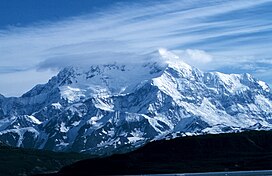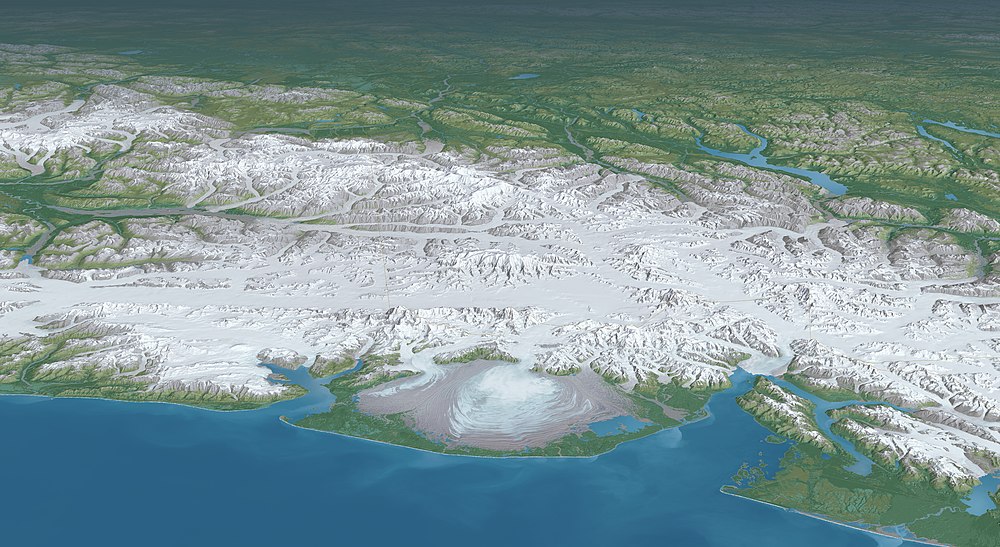Saint Elias Mountains
| Saint Elias Mountains | |
|---|---|
 Mt. Saint Elias | |
| Highest point | |
| Peak | Mount Logan |
| Elevation | 5,959 m (19,551 ft)[1] |
| Listing | List of mountain ranges |
| Coordinates | 60°34′02″N 140°24′19″W / 60.56722°N 140.40528°W[2] |
| Dimensions | |
| Length | 300 mi (480 km) |
| Width | 90 mi (140 km) |
| Area | 112,509 km2 (43,440 sq mi) |
| Geography | |
| Countries | United States and Canada |
| Provinces | Yukon and British Columbia |
| State | Alaska |
| Range coordinates | 60°30′N 139°30′W / 60.500°N 139.500°W |
| Parent range | Pacific Coast Ranges |
| Borders on | Wrangell Mountains |
The Saint Elias Mountains (
This mountain range is named after Mount Saint Elias, which in turn was named in 1741 by the Danish explorer Vitus Bering.[4]
Geology
The St. Elias Mountains form the highest coastal mountain range on Earth. It formed due to the

The St. Elias Mountains formed at the plate boundary between the Yakutat and North American plates. The up-to-12-kilometre (7.5 mi)-thick sediments that have been deposited on top of the Yakutat plate became imbricated and deformed as they were scraped off and compose today the southern (coastal) flanks of the St. Elias Mountains. In contrast the high elevated regions of the drainage divide (Bagley Icefield, Seward Glacier) and north of it are composed of rocks that are part of the North American plate.[8] The highest peaks of the St. Elias Mountains are located in the high ice field region of the
Ranges
The mountains are divided by the Duke Depression, with the shorter, more rounded Kluane Ranges to the east, and the higher Icefield Ranges to the west. Sub-ranges of the Saint Elias include the Alsek Ranges, the Fairweather Range, and the Centennial Range.[10]
Highest mountains
The highest mountains of the range include:
| Mountain | Height | Location | Notes | |
|---|---|---|---|---|
| m | ft | |||
| Mount Logan | 5,959 | 19,551 | Yukon | Highest mountain in Canada |
| Mount Saint Elias | 5,489 | 18,008 | Alaska-Yukon | Second highest in both Canada and the United States |
| Mount Lucania | 5,226 | 17,147 | Yukon | #3 in Canada |
| King Peak | 5,173 | 16,971 | Yukon | #4 in Canada |
| Mount Steele | 5,073 | 16,644 | Yukon | #5 in Canada |
| Mount Bona | 5,005 | 16,421 | Alaska | #5 in the United States |
| Mount Wood | 4,842 | 15,885 | Yukon | #7 in Canada |
| Mount Vancouver | 4,812 | 15,787 | Yukon | #15 in North America |
| Mount Churchill | 4,766 | 15,638 | Alaska | 4th highest volcano in the United States |
| Mount Slaggard | 4,742 | 15,557 | Yukon | #10 in Canada |
| Mount Macaulay | 4,690 | 15,387 | Yukon | |
| Mount Fairweather | 4,671 | 15,325 | Alaska-British Columbia | #1 in British Columbia[11] |
| Mount Hubbard | 4,577 | 15,015 | Alaska-Yukon | #8 in United States, #12 in Canada |
| Mount Bear | 4,520 | 14,831 | Alaska | #18 in United States |
| Mount Walsh | 4,507 | 14,787 | Yukon | |
| Mount Alverstone | 4,439 | 14,565 | Alaska-Yukon | |
| University Peak | 4,410 | 14,470 | Alaska | |
| McArthur Peak | 4,389 | 14,400 | Yukon | |
| Mount Augusta | 4,289 | 14,070 | Alaska-Yukon | |
| Mount Kennedy | 4,250–4300 | ~14,000 | Yukon | |
| Mount Cook | 4,196 | 13,766 | Alaska-Yukon | |
Image
References
- ^ "Topographic map of Mount Logan". opentopomap.org. Retrieved 2023-05-28.
- ^ "Mount Logan". Geographical Names Data Base. Natural Resources Canada. Retrieved 2023-05-28.
- ^ "Saint Elias Mountains". Geographic Names Information System. United States Geological Survey, United States Department of the Interior. Retrieved 2007-12-03.
- ^ "Saint. Elias Mountains". BC Geographical Names. Retrieved 2013-12-27.
- doi:10.1130/G31170.1.
- .
- ^ .
- ^ Plafker, G.; Berg, H.C., eds. (1994). The Geology of Alaska. Boulder: Geological Society of America. pp. 389–449. Retrieved 2023-11-05.
- doi:10.1038/NGEO502.
- ^ "Saint Elias Mountains". Bivouac.com. Retrieved 2013-03-15.
- ^ Mount Fairweather is only partly in British Columbia. The highest peak entirely within British Columbia is Mount Waddington in the Coast Range, 4019 m (13186 ft).
- Sources
- Richter, Donald H.; Preller, Cindi C.; Labay, Keith A.; Shew, Nora B. (2006). Geologic Map of the Wrangell-Saint Elias National Park and Preserve, Alaska. USGSScientific Investigations Map 2877.
- Winkler, Gary R. (2000). A Geologic Guide to Wrangell—Saint Elias National Park and Preserve, Alaska: A Tectonic Collage of Northbound Terranes. ISBN 978-0-607-92676-7.
- Wood, Charles A.; Kienle, Jürgen, eds. (1990). Volcanoes of North America. ISBN 978-0-521-43811-7.


